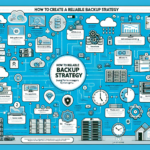Implementing georedundancy for IT infrastructure involves designing and deploying systems and processes that ensure your applications, data, and services remain available and secure even in the event of a disaster or outage at one geographic location. Here’s a detailed guide:
1. Understand Your Requirements
- RPO (Recovery Point Objective): How much data loss is acceptable? This determines the frequency of data replication.
- RTO (Recovery Time Objective): How quickly must services be restored?
- Critical Components: Identify mission-critical systems, applications, and data that require georedundancy.
- Compliance: Consider legal or regulatory requirements (e.g., GDPR, HIPAA).
2. Select Geographically Diverse Locations
- Choose locations in different regions or countries to minimize risk from localized disasters (e.g., earthquakes, floods).
- Ensure proximity to users for performance optimization while balancing redundancy needs.
3. Design a Multi-Site Architecture
- Active-Active: Both sites are operational and handle traffic simultaneously. Requires robust load balancing and synchronization tools.
- Active-Passive: One site is active, and the other is on standby to take over in case of failure. Easier to implement but may have longer failover times.
4. Implement Data Replication
- Storage Solutions: Use enterprise-grade storage systems that support replication to remote locations (e.g., NetApp SnapMirror, Dell EMC SRDF, Zerto).
- Database Replication: Configure database replication (e.g., SQL AlwaysOn, Oracle Data Guard, MySQL replication) to keep data consistent across sites.
- Backup Strategy: Implement off-site backups with tools like Veeam, Commvault, or Cohesity to ensure data recovery.
5. Deploy Cloud or Hybrid Solutions
- Use public cloud providers (AWS, Azure, Google Cloud) for georedundancy. They offer built-in services like:
- AWS: Multi-AZ deployments, cross-region replication.
- Azure: Geo-redundant storage (GRS), paired regions.
- Google Cloud: Regional and multi-regional storage.
- Hybrid solutions combine on-premise infrastructure with cloud redundancy.
6. Use Load Balancing and DNS Failover
- Global Load Balancers: Deploy solutions like AWS Elastic Load Balancing, Azure Traffic Manager, or F5 BIG-IP to distribute traffic across multiple sites.
- DNS Failover: Configure DNS services (e.g., Route 53, Cloudflare, Akamai) to redirect traffic to a secondary site during outages.
7. Implement High Availability and Fault Tolerance
- Virtualization: Use VMware vSphere, Hyper-V, or KVM to replicate virtual machines across sites.
- Kubernetes: Deploy applications in Kubernetes clusters across multiple regions using tools like Kubefed or service mesh solutions (e.g., Istio, Linkerd).
- GPU Workloads: Ensure GPU servers (e.g., NVIDIA DGX, A100 systems) are replicated or backed up for AI workloads.
8. Automate Disaster Recovery (DR)
- Deploy automated DR solutions to ensure seamless failover:
- VMware Site Recovery Manager (SRM)
- Azure Site Recovery (ASR)
- AWS Elastic Disaster Recovery (EDR)
- Test DR plans regularly to ensure readiness.
9. Secure Communication Between Sites
- Use encrypted VPN tunnels or dedicated circuits (e.g., MPLS or SD-WAN) for secure communication between datacenters.
- Implement firewalls, intrusion detection systems (IDS), and zero-trust principles across all locations.
10. Monitor and Optimize
- Centralized Monitoring: Use tools like Prometheus, Grafana, Zabbix, or Datadog to monitor infrastructure across locations.
- Performance Testing: Regularly test latency, throughput, and failover mechanisms.
- Alerts: Configure alerts to notify IT teams of any issues or failover events.
11. Document and Train
- Document your georedundancy architecture, DR plans, and failover procedures.
- Train IT staff on failover processes and tools.
12. Budget Planning
- Georedundancy is costly, so allocate budget for:
- Hardware and software solutions.
- Networking costs.
- Ongoing monitoring and maintenance.
Example Use Case
For an AI workload using GPUs:
1. Deploy Kubernetes clusters with GPU nodes in two different regions.
2. Use Velero or Stash for Kubernetes backup and restore.
3. Store AI models and datasets in geo-redundant cloud storage.
4. Implement TensorFlow Serving or similar tools in both regions for failover.
By following these steps, you can achieve a robust georedundancy setup, minimizing downtime and ensuring business continuity across your IT infrastructure.



